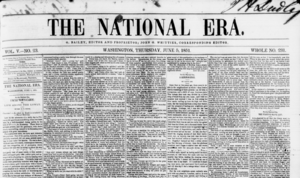The National Era facts for kids
The National Era was an important newspaper published every week in Washington, D.C.. It was printed from 1847 to 1860. This newspaper was known for supporting the movement to end slavery.
Gamaliel Bailey was the editor when the newspaper first started. In 1847, The National Era explained its goals. It said it would focus on discussing slavery and what citizens should do about it. The newspaper also aimed to support the ideas of the Liberty Party. It wanted to find the truth, not just win for a political group.
Each newspaper had four pages. These pages had seven, and later eight, columns of text. The National Era was known for being quite large and having a special way its words looked.
Many famous writers shared their work in The National Era. John Greenleaf Whittier was an associate editor for the paper. The very first time Harriet Beecher Stowe's famous book, Uncle Tom's Cabin, was published, it appeared in this newspaper as a series of stories in 1851. Another well-known story, The Great Stone Face by Nathaniel Hawthorne, also first appeared here.
After Mr. Bailey passed away in 1859, his wife, Margaret Lucy Shands Bailey, took over. She was the publisher until the newspaper stopped printing in February 1860.
What Was "The Soft Answer"?
Just two months after The National Era began, a short story called "The Soft Answer" was printed. It was on the back page and written by Timothy Shay Arthur.
This story was about two friends, Mr. Singleton and Mr. Williams, who had a business problem. A lawyer named Mr. Trueman was helping them solve it. Mr. Williams offered a deal that Mr. Singleton didn't like. Singleton wanted to send an angry reply. But his lawyer, Mr. Trueman, convinced him not to. Instead, Singleton agreed to send a much kinder and more helpful reply that Trueman wrote.
That kind and helpful reply helped the two former friends make up. This idea became known as "The Soft Answer." It suggested that big changes, like ending slavery, could happen slowly, step by step.
How "The Soft Answer" Related to Slavery
The idea of "The Soft Answer" was about taking small, gradual steps to help two sides agree. Many people thought this approach could help the North and South work together. They believed it could lead to the end of slavery. They also hoped it would help African Americans become a full part of society.
See also


